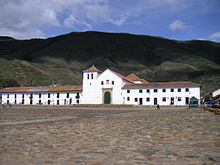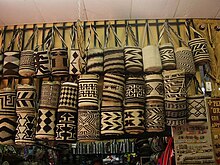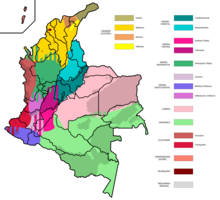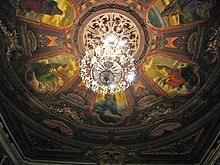Culture of Colombia
This article needs additional citations for verification. (September 2013) |

| Part of a series on the |
| Culture of Colombia |
|---|
 |
| Society |
| Topics |
|
| Symbols |
Many aspects of Colombian culture can be traced back to the early
After independence from Spain, the
Influences



Geography and climate
The hydrography of Colombia is one of the richest in the world. Its main rivers are
The striking variety in temperature and precipitation results principally from differences in elevation. Temperatures range from very hot at sea level to relatively cold at higher elevations but vary little with the season. Temperatures generally decrease about 3.5°F (2°C) for every 1,000-ft (300-m) increase in altitude above sea level, presenting perpetual snowy peaks to hot river valleys and basins. Rainfall is concentrated in two wet seasons (roughly corresponding to the spring and autumn of temperate latitudes) but varies considerably by location. Colombia's Pacific coast has one of the highest levels of rainfall in the world, with the south east often drenched by more than 200 in (500 cm) of rain per year. On the other hand, rainfall in parts of the Guajira Peninsula seldom exceeds 30 in (75 cm) per year. Rainfall in the rest of the country runs between these two extremes.[citation needed]
Colombians customarily describe their country in terms of the climatic zones. Below 900 meters (2,953 ft) in elevation is the
About 86% of the country's total area lies in the tierra caliente. Included in this, and interrupting the temperate area of the Andean highlands, are the long and narrow extension of the Magdalena Valley and a small extension in the Cauca Valley. The tierra fría constitutes just 6% of the total area, but supports about a quarter of the country's population.[citation needed]
Natural regions

Because of its natural structure, Colombia can be divided into six very distinct natural regions.
- Amazon Region: Comprises the part South of the eastern region of Colombia, flat low-lying region. It is the region of the Amazon jungle of Colombia.
- .
- Caribbean Region: The region of the Colombian Caribbean coastal plains and mountainous groups which do not belong to the Andes as the Sierra Nevada de Santa Marta.
- Insular Region: comprises the areas outside the continental territories of Colombia in the Caribbean region as the islands of San Andrés and Providencia and the islands of Gorgona and Malpelo in the Pacific Ocean.
- Orinoquía Region: North of the eastern region of Colombia that belongs to the Orinoco River watershed, flat low-lying region. Also known colloquially as the Eastern Plains.
- Pacific Region: It includes the coastal plains of the pacific coast and the mountainous groups which do not belong to the Andes, in particular the Serranía del Baudó.
Cultural influences
Indigenous influences
The culture of Colombia has vibrant indigenous influences within its culture. Full Indigenous peoples of Colombia are estimated to be around 4-10% of the country’s population Colombia did not receive substantial immigration after the period of Spanish rule. Some exceptions are the capital city of 
Multicultural elements
Immigrantion and foreign influences


A few Japanese families settled in Colombia, inspired by the bucolic description of the Cauca Valley in Jorge Isaacs' novel María. The heads-of-household of Japanese descent would be interred in prisons near Zipaquirá, during World War II.[9]
Colombian politicians, intellectuals, and members of elite society turned to England and France for inspiration in the period, following independence from Spain. Colombian's civil code (adopted in 1887) is based on the Napoleonic Code. French architect Gastón Lelarge (1861–1934) designed many of the public edifices in Bogotá, as well as the cupola of the church of Saint Peter Claver in Cartagena.[1]
Starting in the 20th century,
Regional identities

Due to existence of geographical and climatic barriers, regions in Colombia remained isolated for much of their history, boosting strong local identities. This is attributed to the fact that Colombia was not a unified nation during the
Despite the
During 20th century, government encouraged migration from inner regions to Amazon basin and San Andrés island, fostering a process of colombianization (see: Colombianization of Leticia, Putumayo and Caquetá).
However,
Other groups with a strong regional identities include:[12]
- Paisas from Antioquia department and Coffee Axis), influenced by Basque and Quimbayan culture, they speak Paisa Spanish;
- Costeños from Indigenous culture and related to another Spanish speaking Caribbean nations, they speak Costeño Spanish;
- Pastusos from Southern Andean region, influenced by Inca culture and related to Ecuadorian Highlands, they speak Pastuso Spanish;
- Chocoanos from Pacific region, influenced mostly by African and Emberá culture, they speak Chocoano Spanish;
- Llaneros from Orinoquia region, influenced by the various indigenous groups and related to border populations from Venezuela, they speak Llanero Spanish.[13]
Education
The educational experience of many Colombian children begins with attendance at a preschool academy until age five (Educación preescolar). Basic education (Educación básica) is compulsory by law.[14] It has two stages: Primary basic education (Educación básica primaria) which goes from first to fifth grade – children from six to ten years old, and Secondary basic education (Educación básica secundaria), which goes from sixth to ninth grade. Basic education is followed by Middle vocational education (Educación media vocacional) that comprises the tenth and eleventh grades. It may have different vocational training modalities or specialties (academic, technical, business, and so on.) according to the curriculum adopted by each school.
After the successful completion of all the basic and middle education years, a high-school diploma is awarded. The high-school graduate is known as a bachiller, because secondary basic school and middle education are traditionally considered together as a unit called bachillerato (sixth to eleventh grade). Students in their final year of middle education take the
Bachilleres (high-school graduates) may enter into a professional undergraduate career program offered by a university; these programs last up to five years (or less for technical, technological and intermediate professional education, and post-graduate studies), even as much to six to seven years for some careers, such as medicine. In Colombia, there is not an institution such as college; students go directly into a career program at a university or any other educational institution to obtain a professional, technical or technological title. Once graduated from the university, people are granted a (professional, technical or technological) diploma and licensed (if required) to practice the career they have chosen. For some professional career programs, students are required to take the Saber-Pro test, in their final year of undergraduate academic education.[15]
Public spending on education as a proportion of gross domestic product in 2012 was 4.4%. This represented 15.8% of total government expenditure. In 2012, the primary and secondary gross enrolment ratios stood at 106.9% and 92.8% respectively. School-life expectancy was 13.2 years. A total of 93.6% of the population aged 15 and older were recorded as literate, including 98.2% of those aged 15–24.[16]
Family
The family is a highly important institution to Colombians as engraved by the traditional Roman Catholic church teachings. Members of the extended family are close and children rarely move far away from their parents. There is a deep sense of familial responsibility that stretches through many generations.[citation needed]
Traditionally, men were usually the head of the household, in charge of earning most of the family's income, while women were responsible for
At a child's baptism, the parents of the child will choose godparents, padrinos. A child's padrinos will play an important role in their life, giving advice.[citation needed]
Political attitudes
The Politics of Colombia take place in a framework of a
Food
There is a large variety of dishes that take into account the difference in regional climates. For example:
- In the city of Medellín, the typical dish is the bandeja paisa. It includes beans, rice, ground meat or carne asada, chorizo, fried egg, arepa, and chicharrón. It is usually accompanied by avocado, tomato, and special sauces.[17]
- In the city of ]
- In Bogotá and the Andean region, egg soup.[citation needed]
- In the Caribbean coast, seafood is popular, including fish and lobster. Coconut rice is a common dish along the coastal cities, as are patacones, or fried plantain patties.[18]
- In the Llanos, meat from the barbecue, such as the "ternera llanera" is common, and also typical river fishes like the "amarillo".[citation needed]
- In the Amazonas, the cuisine is influenced by Brazilian and Peruvian traditions.[citation needed]
Inland, the dishes reflect the mix of cultures, inherited mainly from
- In the spices. They are wrapped in plantain leaves and boiled for three to four hours. It also typical to have Pandebono for breakfast, with hot chocolate.[19]
- On the Islands of San Andres, Providencia, and Santa Catalina, the main dish is rondon, a cassava root (yuca), sweet potato, white yams, and pumpkin seasoned with chili peppers and herbs. They also have a crab soup which is considered a delicacy. It is made with the same ingredients as rondon, without the fish.[citation needed]
- Ají picante, a spicy, cilantro-based sauce, is used as a condiment for many dishes and sides, including empanadas, patacones, and soups. This traditional sauce is from the city of Antioquia.[citation needed]
Festivals in Colombia
-
Barranquilla's Carnival
Folklore

Painting

Colombians have been producing
In the colonial time, the painting was characterized by the works of the three Figueroa, pioneers of this art: Baltasar de Figueroa, the old; Gaspar the Figueroa, his son and Baltazar de Figueroa, the young. Gaspar was the teacher of important artists, lie Gregorio Vásquez de Arce y Ceballos. José María Espinoza Prieto, painter and engraver, also is important for his portraits, landscapes and caricatures. Epifanio Garay is highlighted, especially by his portraits.[citation needed]
After the war of independence, in 1819, the Colombian art still was dependent of the figurative. Some people explain that delay in the evolution of the Colombian artistic style is due to the geography of the country, that make difficult a contact and dialogue between the different creative tendencies[citation needed]
In the decades between 1920 and 1940, Marco Tobón Mejía, José Horacio Betancur, Pedro Nel Gómez, Ignacio Gómez Jaramillo, Santiago Martínez Delgado, and Alipio Jaramillo created some dynamics in the elaboration of murals. They were influenced by the Mexican art, although with neoclassic and Art Nouveau characteristics. At the beginning of the 1940 decade, are created works that was new in Colombia, inspired in the post-impressionism and the academic French style.[citation needed]
Many historians of art believe that the Colombian art only began to have a distinctive character in the second half of the 20th century, with a new point of view, integrating the cultural and artistic traditional elements, with the concepts of the art in the 20th century. Ignacio Gómez Jaramillo, for example, combine the new techniques with cultural elements, in his Portrait to the Greiff Brothers. Pedro Nel Gómez, highlighted in the drawing, the water color, the fresco, the oil painting, and the sculpture in wood, stone, and bronze, shows, for example in "Autorretrato con sombrero" (1941), his familiarity with the works of Gauguin and Van Gogh. In other works, he reveal the influence of Cézanne. Alejandro Obregon, considered by many as the father of the Colombian art (most by his originality), has been acclaimed by critics and the public, because of his painting of national landscapes characterized by violent strokes and the symbolic and expressionist use of animals (specially birds, like the condor). His work is influenced by Picasso and Graham Sutherland.[citation needed]
In last years, some Colombian artists, such as
Religion
Studies suggest that about 70.9% of Colombians are
The
While Colombia remains a mostly Roman Catholic country by baptism numbers, the 1991 Colombian constitution guarantees freedom of religion and all religious faiths and churches are equally free before the law.[24]
Literature
Other important writers are Álvaro Mutis, winner of the Cervantes Prize, Jorge Isaacs, who wrote "María", Gonzalo Arango, founder of the
Colombian theatre

- Cali Festival Theater
- Cali Performance Festival
- Carnavalada - Theater to the Streets - Open Air Theater Festival of Barranquilla
- Colombian Theater Festival of Medellin - Medellin en Escena
- Festival de teatro Gitanos en Macondo - first week of September in Aracataca, Madalena.
- Iberoamerican Theater Festival of Bogota
- International Theater Festival and Storytellers Encounter of Popayan
- International Theater Festival of Barrancabermeja - Theater for the Peace
- International Theater Festival of Manizales
Film and television

The interest for the film production came late to Colombia. Vicenzo and Francesco Di Doménico, of Italian origin, were the pioneers in the films production. In 1912, it is inaugurated the first movie theater in Colombia: the Salón Olympia, with a capacity of three thousand people. The most outstanding directors of the film production are Sergio Cabrera, Felipe Aljure, Luis Ospina, Víctor Gaviria, and Carlos Mayolo. Between the most recent proposals, we find to Andy Baíz and Juan Felipe Orozco, director of "Al final del espectro". The work of Dago García and Rodrigo Triana is in a commercial line.[citation needed]
Sports

Soccer, or, Association Football (Spanish: fútbol) is the most popular sport in Colombia. Soccer games are popular social events in Colombia. Baseball has become popular in recent years; it is especially popular along the coast, and is strongly promoted all around the country. Édgar Rentería is an example of a famous Colombian baseball player, but football is still the main sport in the country. Boxing and martial arts are also very popular amongst the male population, and all of these are practiced avidly by the youth.[citation needed]
An ancient game called Tejo, inherited from the Muisca, is also played. The object of tejo is to throw a small metal disk at a gunpowder detonator in a small circular area. The winner is calculated by the number of explosions compared to number of throws.[citation needed]
Comedy
Colombian comedy's original birthplace is the radio, since this was the first original mass media with wide coverage of the national territory rendering radio a very important medium for the promotion of comedy. A distinctive representative of
Music
-
Shakira, Colombian singer
-
Medellin
-
Rock Al Parque, one of Latin America's most important rock events
-
Dance of Colombia
Modern Colombian music is a mixture of Native Indigenous, European, and African influences, as well as more modern
Cumbia is a mixture of Spanish, Native Indigenous, and African music, the latter brought by slaves. The style of dance is designed to recall the shackles worn around the ankles of the slaves. In the 19th century,
Music and dancing are very popular in Colombia, with dozens of popular vibrant styles. The most popular local musical styles are
Colombian rock developed after an influence of Rock en español generating fusion of Rock Music with traditional Colombian music and other musical styles.[citation needed]
The musical genre of Colombian
Symbols
See also
- Architecture of Colombia
- Carnival in Colombia
- Colombia in popular culture
- Hispanic culture
- Latin American culture
- List of Colombians
- List of festivals in Colombia
- List of Major League Baseball players from Colombia
References
- .
- ^ Vergara-Figueroa, Aurora. "En la Sucursal del Cielo (In the Branch of Paradise)". Archived (PDF) from the original on 2021-09-01.
- ^ Biblioteca Luis Ángel Arango. Lablaa.org (13 July 2005). Retrieved on 14 May 2012.
- ^ "Indigenous peoples in Colombia". International Work Group for Indigenous Affairs. Retrieved 10 Jan 2024.
- ^ "Informe Latinobarómetro 2018". Latinobarometro. Retrieved October 3, 2022.
- ^ "Latinobarómetro 2018 Colombia" (PDF). Latinobarometro. Retrieved January 7, 2024.
- ^ Rivera, Marcela (23 August 2018). "The DNA Of: Arepas". Archived from the original on 2021-07-17. Retrieved 2021-07-17.
- ^ http://www.lamochilaarhuaca.com [bare URL]
- ^ a b "ColArte | el Arte en Colombia | ETNIAS Grupo". Archived from the original on 2007-09-27. Retrieved 2007-08-08.
- ^ "Entrada". 23 March 2020.
- ^ María Paula Saffon Sanín (2013-01-05). "El nuevo nacionalismo colombiano" (in Spanish). Dejusticia.
- ISBN 978-0-313-31617-3, archivedfrom the original on 2010-08-03, retrieved 2008-07-30
- ^ Rausch, Jane M. (15 July 1989). "Rebelión en los llanos colombianos: "el affaire Arauca" de 1917". Boletín Cultural y Bibliográfico (in Spanish). 26 (20). Bank of the Republic: 33–60.
- ^ Colombian Constitution of 1991 (Title II - Concerning rights, guarantees, and duties - Chapter 2 - Concerning social, economic and cultural rights - Article 67)
- ^ "Ministerio de Educación de Colombia, Estructura del sistema educativo". 29 June 2007. Archived from the original on June 29, 2007.
- ^ "UNESCO Institute for Statistics Colombia Profile". Uis.unesco.org. Retrieved 27 June 2014.
- ^ "Traditional Colombian Dish: The Filling Bandeja Paisa". Uncover Colombia. Retrieved 2021-07-11.
- ^ July 3; Comments, 2011 | Carolina Restrepo |. "Arroz Con Coco: Colombian Speciality". Smithsonian Folklife Festival. Retrieved 2021-07-11.
{{cite web}}: CS1 maint: numeric names: authors list (link) - ^ "Pan de bono | Traditional Bread From Colombia | TasteAtlas". www.tasteatlas.com. Retrieved 2021-07-11.
- ^ https://www.researchgate.net/publication/257154752_Pre-hispanic_goldwork_technology_The_Quimbaya_Treasure_Colombia [bare URL]
- ISBN 978-958-761-465-7. Archived from the original (PDF) on 2016-03-27. Retrieved 2016-03-27.)
{{cite book}}: CS1 maint: numeric names: authors list (link - ^ Beltrán Cely; William Mauricio. "Descripción cuantitativa de la pluralización religiosa en Colombia" (PDF). Universitas humanística 73 (2012): 201–238. – bdigital.unal.edu.co. Archived from the original (PDF) on 2014-03-29. Retrieved 2015-02-05.
- ^ "Religion in Latin America, Widespread Change in a Historically Catholic Region". Pewforum.org. Pew Research Center. 13 November 2014.
- ^ Colombian Constitution of 1991 (Title II – Concerning rights, guarantees, and duties – Chapter I – Concerning fundamental rights – Article 19)
- ^ "Competitive specialised film festivals". fiapf.org. Archived from the original on 11 November 2016. Retrieved 23 May 2016.
Bibliography
- Londoño Vélez, Santiago (2001). Colombian Art: 3,500 Years of History. ISBN 958-96982-7-1.
- Safford, Frank; Mauricio Palacios (2002). Colombia: Fragmented Land, Divided Society (Latin American Histories). ISBN 0-19-504617-X.
- United States Air Force Culture and Language Center (2015). Expeditionary Culture Field Guide. Colombia (PDF). Maxwell Air Force Base, AL: Air Force Culture & Language Center. Archived from the original (PDF) on 16 May 2016. Retrieved 9 May 2016.
External links
- Digital collection at Luis Ángel Arango Library (in Spanish), Archived 2010-09-23 at the Wayback Machine
- Music Llanera
- Dancing Devils in Corpus Christi Festival, Sierra Nevada
- Overview of Colombian Culture










